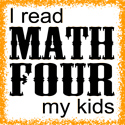
Seems that now days, the way you and I learned multiplication and division is too old fashioned to teach. Don't believe me? Check out this quick and well-delivered video for some alarming new Math trends that American public schools are adopting. I feel that while some of these new methods are entertaining and enjoyable to teach, they should NOT replace standard nationally-used algorithms.
Buzz Words: Homeschooling, Children, Homeschool, Public School, Mathematics, Education, Math, Lessons, America, Learning, Teaching Methods, Lesson Plans, Learning, Heritage, Elementary, Curriculum, School, Textbooks















































5 comments:
That video is ridiculous! I can't imagine trying to teach math via an Atlas. I was interested to see the "lattice method" in Everyday Math though. It's a really party trick, but doesn't really help kids learn what's happening.
However, I was somewhat impressed with the partial quotients method. I can solve long division problems (to 6-7 digits by any #, so not huge) quickly in my head using this method, and was always surprised schools didn't teach it.
I think the ability for a child to approximate is just as important in the real world as the ability to get the exact right answer, and approximations are something a child will never learn with a calculator.
I'm still a huge fan of no calculators in math class until at least 8th or 9th grade (algebra), when the calculator is more for support and less for solving the problem.
Have a great day!
Oy... that made my head hurt!!
We'll just stick with the good, old reliable methods that I used when I learned!
I agree with the calculator thing, Anita. We don't use one (except sometimes to quickly check work). I had to show my son HOW to use one last year for his exam with the state (because they allowed them for the Math portion in third grade!). I thought it was awful that they were letting 3rd graders use those things!
Erica - I'm glad it's not just me thinking these textbooks are a little liberal and fluffy.
I finally understand why my intelligent son has such a difficult time with basic multiplication and division! We pulled him out of school at the end of second grade, apparently not soon enough. Those math programs are a joke.
There are no fewer than four grammatical errors in your blog post.
Post a Comment